Bennemann K.H., Ketterson J.B. Superconductivity: Volume 1: Conventional and Unconventional Superconductors; Volume 2: Novel Superconductors
Подождите немного. Документ загружается.


1170 M. Lang and J. M¨uller
to the metallic/superconducting -(ET)
2
Cu(NCS)
2
salt, the optical conductivity in the low-energy re-
gion for insulating -(ET)
2
Cu[N(CN)
2
]Cl rapidly de-
creases below 50 K, indicating a large temperature-
dependent semiconducting energy gap with a value
of about 900cm
−1
at 10 K [121].
Electron–Phonon Coupling
Infrared reflectivity measurements can also be used
to obtain information on the electron–phonon in-
teraction. In molecular crystals, the coupling be-
tween the conduction electrons and the phonons
is twofold. One kind of interaction, the so-called
electron-molecular-vibration (EMV) coupling, in-
volves the intramolecular vibrations which are char-
acteristic of the molecular structure. This has to
be distinguished from the electron-intermolecular-
vibration coupling which refers to the interaction
of the charge carriers with motions of almost rigid
molecules around their equilibrium positions and
orientations (translational and librational modes).
Electron- Molecular-Vibration Coupling
It iswellknown[122] thatelectronsin the HOMO’sof
the TTF molecule and its derivatives couple strongly
to the totally symmetric (A
g
)molecularvibrations
via the modulation of the HOMO energy, E
HOMO
,by
the atomic displacements. The linear EMV coupling
constant g
i
for mode i is defined as:
g
i
=
1
h
i
∂E
HOMO
∂Q
i
, (20.4)
where Q
i
is an intramolecular normal coordinate
and
i
the mode frequency. The effective electron-
intramolecular-phonon coupling constant
i
can
then be calculated using
i
=2g
2
i
h
i
N(E
F
)where
N(E
F
) is the density of states at the Fermi level.
The sharp features superimposed on the elec-
tronic background in Fig. 20.13 can be attributed to
molecular vibrations. An assignment of these fea-
tures to the various vibrational modes
4
is feasible
by comparing spectra of different isotopically la-
beled salts with calculations based on a valence-
force-field model by Kozlov et al. [125,126]. For the
ET molecule, the modes with the strongest coupling
constants are those involving the central carbon and
sulfur atoms [125–127] at which the HOMO’s have
the largest amplitudes [34]. The frequencies of these
C=C stretching and ring-breathing modes are
2
=
1465 cm
−1
(g
2
=0.165),
3
= 1427 cm
−1
(g
3
=0.746)
and
9
= 508 cm
−1
(g
9
=0.476), where the calculated
coupling constants are given in the brackets. Despite
these sizable coupling constants, several studies, es-
pecially those of the mass isotope shifts on T
c
for the
ET salts [128],indicate that the EMV coupling seems
to play only a minor role in mediating the attractive
electron–electron interaction, cf. Sect. 20.4.5.
Electron-Intermolecular-Vibration Coupling
While much experimental data are available on the
EMV coupling, relatively little is known about the
coupling of the charge carriers to the low-lying in-
termolecular phonons. This interaction is provided
bythe modulationof the charge-transfer integrals t
eff
between neighboring molecules during their trans-
lational or librationalmotions.Within the Eliashberg
theory, the dimensionless electron-intermolecular-
phonon coupling constant is given by
=2
˛
2
(!)
!
F(!)d! , (20.5)
where ˛(!) is the electron–phonon coupling con-
stant, ! the phonon frequency and F(!)the
phonon density of states. The Eliashberg function
˛
2
(!)F(!) can, in principle, be derived from tun-
neling characteristics of strong-coupling supercon-
ductors or via point-contact measurements. The lat-
ter experiments have been carried out by Nowack
et al. on the ˇ-type (ET)
2
X salts with X = I
3
and AuI
2
[129, 130] yielding 1. Some of
the frequencies of the intermolecular modes have
been determined by employing Raman and far-
infrared measurements [59, 131–133]. More recent
studies including inelastic-neutron [62] and Raman-
scattering [56–59] have focused on investigation
4
Important references are [54,120,123,124], see [9,113] for both earlier and more recent citations.
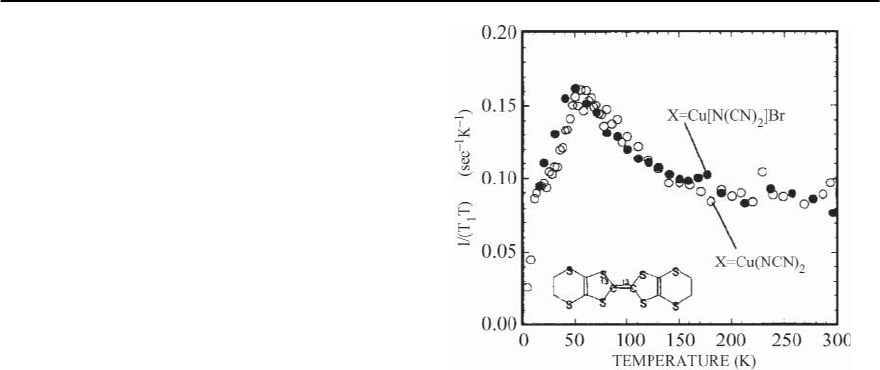
20 Organic Superconductors 1171
of the role of intermolecular phonons for super-
conductivity. These experiments yielded quite siz-
able superconductivity-induced phonon-renormali-
zation effectswhichclearlyindicateasignificantcou-
pling of the superconducting charge carriers to the
intermolecular phonons and suggest an important
role of these modes in the pairing interaction, cf.
Sect. 20.4.5.
20.3.3 Thermal and Magnetic Properties
Common to both the quasi-1D and quasi-2D charge-
transfer salts is the variety of ground states the sys-
tems can adopt depending on parameters such as the
chemical composition or external pressure. Most re-
markable is the fact that for both families the super-
conducting phase shares a common phase boundary
with a long-range magnetically ordered state.
For the (TMTSF)
2
PF
6
salt,cooling atambient pres-
sure leads to a metal–insulator transition at T
MI
∼
12 K. The insulating ground state in the (TMTSF)
2
X
series has been identified via NMR [134, 135] and
susceptibility[136] measurements as a spin-density-
wave ordering whose wave vector q =2k
F
is de-
termined by the optimum nesting condition of the
quasi-1D Fermi surface [6]. The application of hy-
drostatic pressure to the X = PF
6
salt suppresses the
magnetic state by destroying the nesting properties
and instead stabilizes superconductivity below about
T
c
=1.1 K at 6.5 kbar [137].Ashas been shown again
by NMR experiments, short-range spin-fluctuations
withthesamewavevectorq remain active up to
∼ 100 K, i.e. far above the SDW ordering in this salt.
Moreover, these fluctuations are present also in the
normal state of the ClO
4
compound despite its su-
perconducting ground state [138].
For the quasi-2D -phase (ET)
2
X compounds, the
nesting properties are expected to be less strongly
pronounced, cf. the Fermi surface in Fig. 20.7. Nev-
ertheless, as in the case of the quasi-1D salts, super-
conductivity lies next to an antiferromagnetic insu-
lating state in the pressure-temperature phase dia-
gram,see Sect.20.3.5.While the compounds with the
complex anions X=Cu(NCS)
2
and Cu[N(CN)
2
]Br are
superconductors with T
c
values of 10.4K and 11.2K,
respectively, -(ET)
2
Cu[N(CN)
2
]Cl is an antiferro-
Fig. 20.14. Spin-lattice relaxation rate divided by
temperature, (T
1
T)
−1
,for-(ET)
2
Cu(NCS)
2
and -
(ET)
2
Cu[N(CN)
2
]Br as a function of temperature, taken
from [141].For the
13
C-NMR measurements, the
12
Catoms
of the central C = C double bond in the ET molecule have
been replaced by
13
C
magnetic insulator with T
N
=27Kwhichcanbe
transformed into a superconductor with T
c
=12.8K
by the application of a small hydrostatic pressure of
only 300 bar [25].Likewise seen in the quasi-1Dsalts,
the metallic state above T
c
in these quasi-2D sys-
tems reveals indications for magnetic fluctuations.
This has been demonstrated by NMR measurements
on the various -(ET)
2
X salts [139–143]. As shown
in Fig. 20.14 the spin-lattice relaxation rate divided
by temperature, (T
1
T)
−1
, for the superconductors -
(ET)
2
Cu(NCS)
2
and -(ET)
2
Cu[N(CN)
2
]Br behaves
quite differently from what would be expected for
a simple metal and realized to a good approxima-
tion in some other organic superconductors as, e.g.
˛-(ET)
2
NH
4
Hg(SCN)
4
[96, 141]. For both -phase
compounds, the (T
1
T)
−1
values at higher tempera-
tures are enhanced by a factor 5 ∼ 10 compared to
a conventional Korringa-type behavior. Upon cool-
ing, (T
1
T)
−1
gradually increases down to a tem-
perature T
∗
50 K, below which a steep decrease
sets in. Both the overall enhancement of (T
1
T)
−1
along with its anomalous peak around 50 K have
been assigned to the effect of strong antiferromag-
netic spin fluctuations with a finite wave vector
[96,139,141,144]. The latter might be related to the

1172 M. Lang and J. M¨uller
Fig. 20.15. Knight-shift, K
S
,for-(ET)
2
Cu[N(CN)
2
]Br as
a function of temperature at ambient pressure and p =
4 kbar, taken from [139]
ordering wave vector that characterizes the AF phase
of -(ET)
2
Cu[N(CN)
2
]Cl [96, 139, 144]. It has been
emphasized by these authors that despite the rapid
drop below T
∗
50 K the overall enhancement of
(T
1
T)
−1
persists until the onset of superconductiv-
ity indicative of the highly-correlated nature of the
metallic state in these compounds [96,141].NMR in-
vestigations performed at variouspressures revealed
that with increasing the pressure,the maximum at T
∗
shifts to higher temperatures while its size becomes
progressively reduced. At pressures above 4 kbar the
peak is replaced by a normal Korringa-type behavior,
i.e. (T
1
T)
−1
=const. [139,140].In [95,96] the abrupt
reduction of (T
1
T)
−1
below T
∗
50 has been linked
phenomenologically to a spin-gap behavior as dis-
cussed also in connection with the high-T
c
cuprates.
Indeed, the formation of a pseudogap was first pro-
posed by Kataev et al. [145] on the basis of their
ESR measurements.These authors observed a reduc-
tion of the spin susceptibility around 50 K, indicat-
ing a decrease of the electronic density of states at
the Fermi level N(E
F
)nearT
∗
. The same conclusion
has been drawn from results of the static magnetic
susceptibility [141] and Knight-shift (K
S
)measure-
ments [139]. Figure 20.15 shows K
S
as a function
of temperature for the -(ET)
2
Cu[N(CN)
2
]Br salt.
While the data at ambient pressure reveal a clear
drop below about 50K, a rather smooth behavior
with a gradual reduction upon cooling was found at
4 kbar [139]. The variation of the spin susceptibility
in the high-temperature region has been attributed
to the lattice contraction [144]. Although these ex-
periments show clear evidence for a reduction of the
density of states at E
F
below T
∗
50, the nature of
this phenomenon and its interrelation to supercon-
ductivity are still unclear.
Cooling through T
∗
50 does not only cause
anomalies in the above magnetic properties but
also leads to clear signatures in transport, acous-
tic, optical and thermodynamic quantities. As men-
tioned above, for both superconducting compounds
a distinct peak shows up in the temperature deriva-
tive of the electrical resistivity d/dT [93, 94] in-
dicating a change in the density of states at E
F
.A
pronounced softening of ultrasound modes for -
(ET)
2
Cu[N(CN)
2
]Br and -(ET)
2
Cu(NCS)
2
with dis-
tinct minima at T
∗
38 K and 46 K, respectively,
have been attributed to a coupling between acous-
tic phonons and antiferromagnetic fluctuations
[146,147]. An interaction between the phonon sys-
tem and magnetism has also been suggested by Lin
et al. based on their Raman scattering experiments
[115,148].Recent theoretical studies have attempted
to explain both the acoustic and Raman experiments
by a correlation-induced crossover from a coherent
Fermi liquid at low temperatures to an incoherent
bad metal at high temperatures [97,149].According
to this work, pronounced phonon anomalies as well
as anomalous transport and thermodynamic prop-
erties are expected to occur at the crossover temper-
ature T
∗
. Based on their NMR results, Kawamoto et
al. [142] and Kanoda [95,96] argued that T
∗
marks
the crossover temperature from a region of antifer-
romagnetic fluctuations of localized spins at high T
to a Fermi-liquid regime at low temperatures. This
differs from the interpretation given by the Orsay
group [139,140,144]who analyzed their NMR results
in termsof strong antiferromagnetic fluctuations en-
hanced by Coulomb repulsion and the nesting prop-
erties of the Fermi surface.
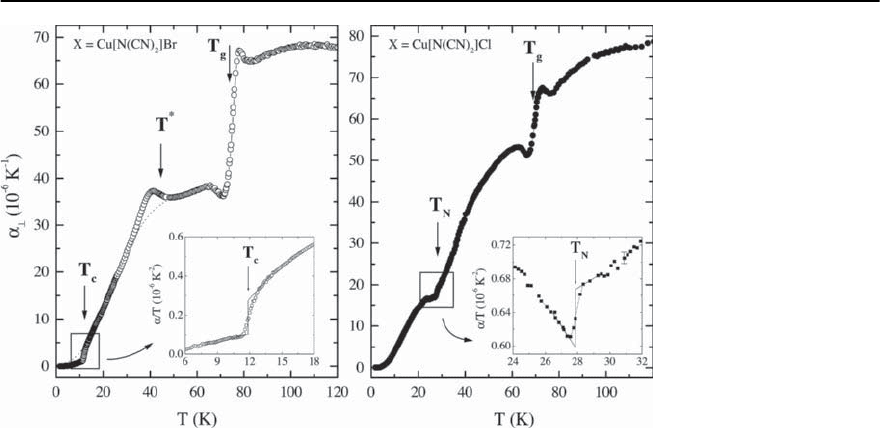
20 Organic Superconductors 1173
Fig. 20.16. Linear thermal expansion coefficient perpendicular to the planes of highest conductivity, ˛
⊥
,asafunctionof
temperature for superconducting -(ET)
2
Cu[N(CN)
2
]Br (left panel) and insulating -(ET)
2
Cu[N(CN)
2
]Cl (right panel).
The inset shows details of ˛
⊥
for both salts as ˛
⊥
/T vs T at the superconducting (X=Cu[N(CN)
2
]Br) and antiferromag-
netic (X = Cu[N(CN)
2
]Cl) phase transition. Arrows indicate different kinds of anomalies as explained in the text, taken
from [99]
More insight into the nature of the anomaly at
T
∗
and its interrelation with superconductivity can
be obtained by studying the coupling to the lat-
tice degrees of freedom. This has been done by
employing high-resolution thermal expansion mea-
surements which also allow for studying directional-
dependent effects [87,99,150].Figure20.16compares
the linear coefficient of thermal expansion, ˛(T)=
∂ ln l(T)/∂T,wherel(T) is the sample length, per-
pendicular to the planes for the superconducting -
(ET)
2
Cu[N(CN)
2
]Br (left panel) with that of the non-
metallic -(ET)
2
Cu[N(CN)
2
]Cl salt (right panel).For
both compounds, various anomalies have been ob-
served as indicated by the arrows [99, 151]. These
are (i) large step-like anomalies at T
g
=70∼ 80 K
which are due to a kinetic, glass-like transition asso-
ciated with the ethylene endgroups, cf. Sect. 20.3.4
and (ii) a distinct peak in ˛(T)atT
∗
. The latter
feature, also observed for the superconductor -
(ET)
2
Cu(NCS)
2
(not shown) is absent in the non-
metallic -(ET)
2
Cu[N(CN)
2
]Cl salt, cf. right panel
of Fig. 20.16 [99]. As demonstrated in the insets of
Fig. 20.16, the transitions into the superconducting
(T
c
=11.8 K) and antiferromagnetic (T
N
=27.8K)
ground states for the X = Cu[N(CN)
2
]Br and X =
Cu[N(CN)
2
]Cl salts,respectively,areaccompanied by
distinct second-order phase transition anomalies in
the coefficient of thermal expansion.
Figure 20.17 shows the anomalous contribu-
tion, ı˛
i
(T)=˛
i
(T)−˛
ib
(T), to the uniaxial
thermal expansion coefficients along the principal
axes, ˛
i
(T), at T
c
and T
∗
for the superconducting
salts X=Cu[N(CN)
2
]Br (left panel) and X=Cu(NCS)
2
(right panel) obtained after subtracting a smooth
background ˛
ib
(dotted line in the left panel of
Fig. 20.16) [100]. Judging from the shape of the
anomalies at T
∗
, i.e. their sharpness and magnitude,
ithasbeensuggestedthat thisfeaturebeassignedto a
second-orderphasetransition[100].Figure 20.17 un-
covers an intimate interrelation between the phase-
transitionanomaliesat T
c
andT
∗
:whilebothfeatures
are correlatedin size,i.e.alarge (small) anomaly atT
c
complies with a large (small) one at T
∗
,theyarean-
ticorrelated in sign. A positive peak at T
c
goes along

1174 M. Lang and J. M¨uller
Fig. 20.17. Anomalous
contributions, ı˛
i
(T)=
˛
i
(T)−˛
ib
(T), to the
uniaxial thermal expansion
coefficients, ˛
i
(T), along
the three principal axes
for the superconducting
salts -(ET)
2
Cu[N(CN)
2
]Br
(left panel)and-(ET)
2
Cu
(NCS)
2
(right panel), taken
from [100]
with a negative anomaly at T
∗
and vice versa.Accord-
ing to the Ehrenfest relation
∂T
∂p
i
p
i
→0
= V
mol
·T
·
˛
i
C
, (20.6)
which relates the uniaxial-pressure dependence of
a second-order phase-transition temperature T
to
the discontinuitiesin ˛
i
, ˛
i
, and that of the specific
heat, C, the above findings imply that the uniaxial-
pressure coefficients of T
c
and T
∗
are strictly anticor-
related.In [99,100] it has been argued that the transi-
tion at T
∗
is not of structural but of electronic origin
and related to the Fermi-surface topology. Based on
the above uniaxial-pressure results, it has been pro-
posed that T
c
and T
∗
mark competing instabilities on
disjunct parts of theFermi surface [99,100]:whilethe
instability at T
∗
most likely involves only the minor
quasi-1D fractions (see Fig. 20.7 and [139]), the ma-
jorquasi-2D partsaresubject to the superconducting
instability at lower temperatures. As a result, these
studies hint at the opening of a real gap associated
with T
∗
on the small 1D-parts of the FS as opposed
to a pseudogap on the major quasi-2D fractions. The
condensation of parts of the FS into a density-wave
below T
∗
would imply the onset of anisotropies in
magnetic and transport properties. In fact, this has
been found in recent orientational-dependent stud-
Fig. 20.18. Temperature dependence of the normal-
ized resistance along the in-plane b and c-axis of -
(ET)
2
Cu(NCS)
2
.Thetop left inset shows the FS and the
Brillouin zone, taken from [101]
ies on both compounds [101]: cooling through T
∗
is accompanied by the onset of a small but distinct
anisotropy in the magnetic susceptibility.As can be
seen in Fig. 20.18, T
∗
affects also the charge degrees
of freedom where below T
∗
the b-axis transport be-
comes more resistive compared to that along the c-
axis [101]. These authors proposed that below T
∗
a

20 Organic Superconductors 1175
static or fluctuating charge-density-wave (CDW) on
minor parts of the FS coexists with the metallic phase
on the remaining quasi-2D fractions.
The above discussion on the nature of the
anomalies at T
∗
for the superconducting salts -
(ET)
2
Cu[N(CN)
2
]Br and -(ET)
2
Cu(NCS)
2
poses the
question whether this phenomenon is related to
the magnetic signatures found in the non-metallic
-(ET)
2
Cu[N(CN)
2
]Cl. Earlier magnetization mea-
surements on -(ET)
2
Cu[N(CN)
2
]Cl revealed a shal-
low decrease below 45 K which was interpreted as
the onset of an antiferromagnetic order [152]. In
addition, indications were found for a weak fer-
romagnetic state at 22 K with a small saturation
moment of 8 · 10
−4
B
/dimer. However, according
to more recent NMR experiments, the spins order
in a commensurate antiferromagnetic structure be-
low T
N
≈ 27 K with a sizable magnetic moment
of (0.4−1.0)
B
/dimer [153]. From these measure-
ments, along with magnetization studies, it has been
inferred that the easy magnetic axis is aligned per-
pendicular to the planes and that a small canting
of the spins causes a weak ferromagnetic moment
parallel to the planes below about 22 ∼ 23 K, see
also [154]. Recent
13
C-NMR experiments confirmed
the commensurate character of the magnetic struc-
ture yielding a moment of 0.45
B
/(ET)
2
[155].
Three different proposals have been put forward
on the origin of the magnetic moments and the
nature of the antiferromagnetic insulating state in
-(ET)
2
Cu[N(CN)
2
]Cl: (i) electron localization due
to lattice disorder accompanied by an incomplete
compensation of their spins, i.e. an inhomogeneous
frozen-in magnetic state[156],(ii)an itinerant SDW-
type magnetism associated with the good nesting
properties of the quasi-1D parts of the Fermi sur-
face [121, 144, 157] and (iii) a correlation-induced
Mott–Hubbard type metal–insulator transition lead-
ing to a magnetic state characterized by localized
spins [153].
Although proposal (i) has been ruled out by a re-
cent thermal expansion study providing clear ther-
modynamic evidence for a phase transition at T
N
[99] (see inset of the right panel of Fig. 20.16), the
nature of the ordered state is still unclear. So far
the results of optical, thermal and magnetic prop-
erties seem to indicate that certain elements of
the models (ii) and (iii) would be applicable to -
(ET)
2
Cu[N(CN)
2
]Cl.
20.3.4 Anion Ordering and Glassy Phenomena
In discussing molecular conductors and supercon-
ductors, an important issue which should not be
overlooked is disorder and its possible implications
on the electronic properties. In this respect we have
to distinguish between different kinds of imperfec-
tions.The extrinsic disorder,i.e.impurityconcentra-
tions, contaminations or crystal defects can be vastly
controlled in the preparation process although some
aspects remain puzzling, see e.g. the discussion on
the resistivity maximum in Sect. 20.3.2. In a study
of the alloy series ˇ-(ET)
2
XwithX=(I
3
)
1−x
(IBr
2
)
x
(0 ≤ x ≤ 1), where the salts with the two limit-
ing compositions with x =0andx =1aresuper-
conductors, a clear correlation between the residual-
resistivity ratio (RRR) and T
c
was found[158].These
experiments show that superconductivity is very sen-
sitive to the induced random potentials which lead
to electron localization. The effect of random poten-
tials created by radiation damage effects, resulting in
a suppression of superconductivity, has been stud-
ied for the Bechgaard salts as well as for ˇ-(ET)
2
I
3
.
For more details, the reader is referred to [5] and
references therein.
(TM)
2
X Salts
However, certain kinds of intrinsic disorder are un-
avoidable and can be of particular importance for
experiments attempting to explore superconducting-
stateproperties.Thelatter type of imperfections con-
cerns materials where, by symmetry, certain struc-
tural elements can adopt one of two possible ori-
entations which are almost degenerate in energy
[159,160].
This can be seen in the (TM)
2
X salts with non-
centrosymmetric anions such as tetrahedral ClO
4
.As
a result,these anions are disordered at room temper-
ature with an equal occupation forboth orientations.
Upon cooling,entropy is gained by a more or less per-
fect ordering oftheanions,depending on howfast the
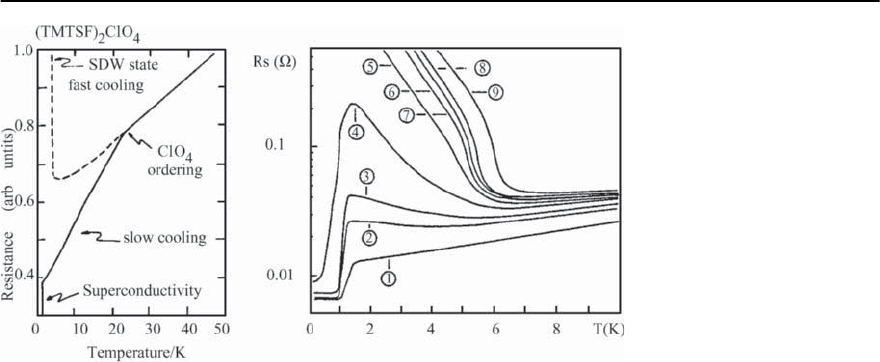
1176 M. Lang and J. M¨uller
Fig. 20.19. Left panel:Ef-
fects of anion ordering in
(TMTSF)
2
ClO
4
at T
AO
=24K,
on the resistivity, from [161].
Right panel: Semilogarithmic
plot of the resistance vs tem-
perature in states with various
degrees of disorder character-
ized by T
Q
numbered from 1 to
9 (see text), from [162]
system is cooled through the ordering temperature
T
AO
. A perfect long-range anion ordering, realized
to a good approximation when cooled sufficiently
slowly, then introduces a new periodicity of the lat-
tice. Depending on the anion this can have quite dif-
ferent implications on the electronic properties: for
the (TMTSF)
2
ClO
4
salt,for example,the anion order-
ing below 24 K is accompanied by a doubling of the
periodicity along the b -axis, i.e. perpendicular to the
stacking axis which leaves the conducting proper-
ties almost unaffected. In contrast, the anion order-
ing for (TMTSF)
2
ReO
4
opens up a large gap at the
Fermi level leading to an insulating ground state. If
the compound had been cooled quickly through T
AO
,
a disordered “quenched”state is adopted at low tem-
peratures whose properties are quite different from
the“relaxed” state obtained after slow cooling.
The left panel of Fig. 20.19 shows the effect
of anion ordering on (TMTSF)
2
ClO
4
.Foraslowly
cooled system, the anion-ordering phase transition
occurs at T
AO
= 24K.Thisisaccompaniedbya
decrease of the resistivity due to the reduction of
scattering by randomly distributed anion potentials.
Upon further cooling, superconductivity sets in with
T
c
=(1.2 ± 0.2) K. In contrast, for a crystal cooled
rapidly, the high-temperature disordered state be-
comes quenched and the system undergoes a metal-
to-insulator transition at T
MI
=6.05 K. The insulat-
ing quenched state has been identified via NMR and
ESR measurements [163,164] as a SDW state with an
energy gap 2
0
/k
B
T
SDW
=3.64 close to the mean-
fieldvalue of 3.52 [162].Thephase transition at T
SDW
has been explored recently by specific heat measure-
ments [165]. The right panel of Fig. 20.19 shows that
the low-temperature resistivity may change over sev-
eral orders of magnitude depending on the thermal
history of the sample. Intermediate states with vari-
ous degrees of frozen anion disorder have been pro-
duced by rapidly cooling the crystal from different
temperatures T
Q
≥ T
AO
. Recent specific heat mea-
surements showed that there is no difference be-
tween the specific heat anomalies at T
AO
of slowly
cooled and those of quenched-cooled samples, i.e.
the structural transition is independent of the ki-
netic conditions.Fromthese results,the authors con-
cluded that the reordering transition of the anions is
of second order and occurs within the experimen-
tal timescales [165]. This is contrary to what would
be expected for a glass-like transition. Such a glassy
behavior, however, has been observed at the order-
ing temperatures of the compounds with X = ReO
4
(T
AO
= 180 K) and FSO
3
(T
AO
=86K).Formorede-
tails see [5,33] and references therein.
-(BEDT-TTF)
2
X Salts
Indications for frozen-in disorder have been also re-
ported for the quasi-2D salts of the -(ET)
2
Xfam-
ily. In an ac-calorimetry study, a glass-like tran-
sition has been found for -(ET)
2
Cu[N(CN)
2
]Br
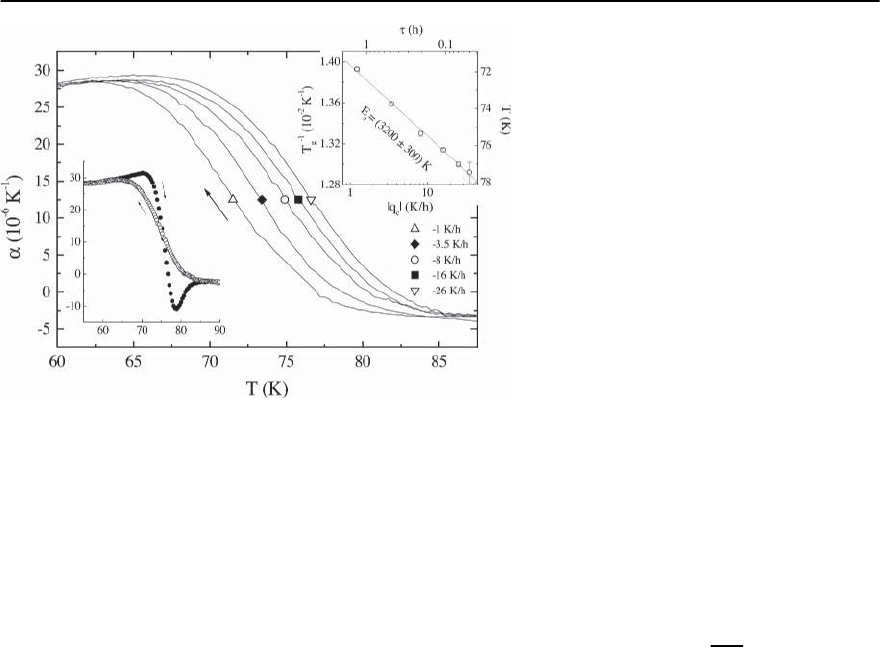
20 Organic Superconductors 1177
Fig. 20.20. Linear thermal expansion coefficient,
˛,vsT measured parallel to the conducting
planes of -(ET)
2
Cu[N(CN)
2
]Br in the vicinity
of the glass transition defined as the midpoint
of the step-like change in ˛ for varying cooling
rates q
c
. Insets: hysteresis between heating and
cooling curves around T
g
(left side)andArrhe-
nius plot of T
−1
g
vs |q
c
|and (right side), where
|q
c
|is the cooling rate and the relaxation time
(taken from [99])
and -(ET)
2
Cu[N(CN)
2
]Cl [166–168]. The authors
observed step-like anomalies in the heat capacity
around 100 K, which have been attributed to a freez-
ing out of the intramolecular motionsof the ethylene
endgroups at the ET molecules. Clear evidence for
a glass-like transition have also been derived from
thermal expansion measurements [99] which are ex-
tremely sensitive to structural rearrangements such
as those involved in the glass-like freezing process.
The outcome of this study confirmed, on the one
hand, the above-mentioned specific heat results and
clarified on the other, the nature of the thermal ex-
pansion anomalies previously reported by Kund et al.
[87,150]. In addition, this study showed that a glass-
like transition also exists for the -(ET)
2
Cu(NCS)
2
salt. A glass transition is due to a relaxation pro-
cess where, below a characteristic temperature T
g
the relaxation time (T) of certain structural ele-
ments or molecules becomes so large that they can
no longer reach thermodynamic equilibrium. As a
result,a short range order, whichis characteristic for
this temperature T
g
, becomes frozen in. Figure 20.20
shows exemplarily the linear coefficient of thermal
expansion for -(ET)
2
Cu[N(CN)
2
]Br measured par-
allel to the conducting planes at temperatures near
T
g
. As discussed in [99] the anomaly at T
g
75K
shows all the characteristics expected for a glassy
transition [169], i.e. a step in the thermal expansion
coefficient,a pronounced hysteresis between heating
and cooling (left inset) and a cooling-rate depen-
dent characteristic temperature T
g
. The inset on the
right side of Fig. 20.20 shows in an Arrhenius plot
the inverse of the glass-transition temperatures, T
−1
g
,
vs the cooling rate |q
c
|. The data nicely follow a lin-
ear behavior as expected for a thermally activated
relaxation time [170,171]:
(T)=
−1
0
· exp
E
a
k
B
T
, (20.7)
where E
a
denotes the activation energy barrier. The
prefactor representsan attempt frequency
0
.Alinear
fit to the data of Fig.20.20 yields E
a
= (3200±300)K.
The characteristic activation energy of the
[(CH
2
)
2
] conformational motion (cf. Fig. 20.4) was
determined to E
a
= 2650 K by
1
H-NMR measure-
ments [144].Thesimilar sizeof the activation energy
derived from Fig.20.20along with the observation of
a mass-isotope shift when replacing the hydrogen
atoms in [(CH
2
)
2
] by deuterium provide clear evi-
dence that the ethylene endgroups are the relevant
entities involved in the relaxation process [99].
An influence of the thermal history of the sam-
ples around 70 ∼ 80 K on the electronic proper-
ties had been realized by various authors and in-
terpreted in different ways. Based on resistance
measurements of structural relaxation kinetics on
-(ET)
2
Cu[N(CN)
2
]Br, Tanatar et al. [88] claimed
that the ethylene-endgroup ordering is associated
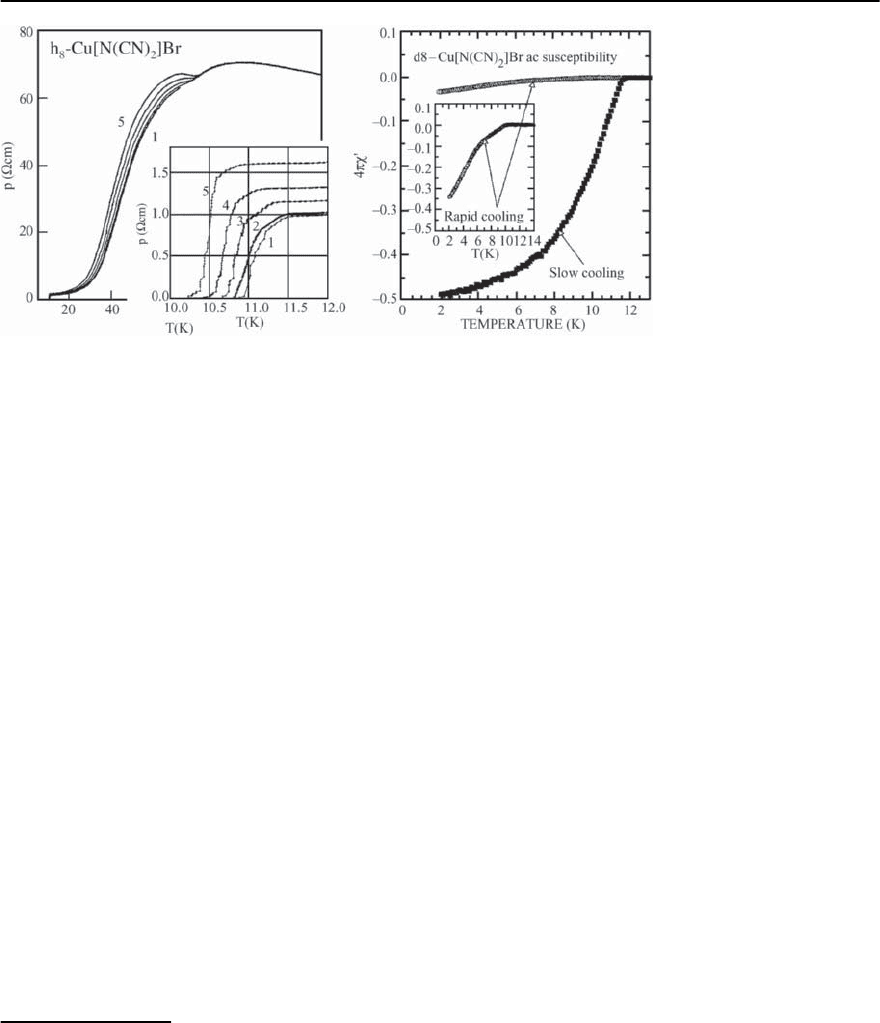
1178 M. Lang and J. M¨uller
Fig. 20.21. Left panel: resistivity as a function of temperature for a sample of -(H
8
-ET)
2
Cu[N(CN)
2
]Br cooled at different
rates ranging from about 0.5 K/min,lower curve (1),to 60 K/min upper curve (5).The inset shows an expansion of the data
near the superconducting transition. Reproduced from [172]. Right panel: ac-susceptibility of -(D
8
-ET)
2
Cu[N(CN)
2
]Br
after slow and rapid cooling (taken from [173])
with a sequence of first-order phase transitions
around 75 K. A pronounced kink in the resistiv-
ity at 75 K accompanied by hysteresis between
heating and cooling had been reported early on
for -(ET)
2
Cu[N(CN)
2
]Br [79, 174]. Similar behav-
ior in the vicinity of T
g
was observed also for
-(ET)
2
Cu(NCS)
2
[86]. Besides that, more recent
measurements on -(ET)
2
Cu[N(CN)
2
]Br yielded in-
teresting time dependences affecting not only the
electronic properties around 70 ∼ 80 K but also the
properties at lower temperatures: Su et al. reported
relaxation effects in R(T)andaseparationofthe
curves below about 80K as a function of the cooling
rate q
c
.As shown in the inset of Fig. 20.21 (left panel)
the residual resistivity increases with increasing |q
c
|
[172,175].Theinset alsoshowsthat theway of cooling
through 70 ∼ 80 K may influence the superconduct-
ing properties such that T
c
decreases on increasing
|q
c
|. In addition, magnetization measurements re-
vealed that with increasing |q
c
|,agrowingamountof
disorder is induced causing an enlarged penetration
depth [176]. In reference [177] an ac-susceptibility
investigation of themagneticpenetrationdepthsand
their dependence on the cooling-rate-dependent in-
trinsic disorder have been performed. The authors
found that the superconducting-state properties are
critically determined by the time scale of the experi-
ment around T
g
.
For the deuterated -(ET)
2
Cu[N(CN)
2
]Br salt, it
has been reported that rapid cooling through 80 K
drives the superconducting ground state into an
insulating antiferromagnetic state [173, 178].
5
As
shown in the right panel of Fig. 20.21 the ac-
susceptibility data reveal a strong suppression of
the superconducting volume fraction with increas-
ing cooling rate [173]. It is tempting to assign the
apparent deterioration of superconductivity to the
frozen disorder at T
g
:viatheC-H···donor and
C-H ···anion contact interactions, disorder in the
ethylene groups introduces a random potential that
may alter the effective transfer integrals t
eff
and, by
this, may destroy superconductivity, see also [36].
5
The ground state of deuterated -(D
8
-ET)
2
Cu[N(CN)
2
]Br is strongly sample dependent; there are both superconduct-
ing as well as non-superconducting samples. In [173] it is claimed that the crystals always contain superconducting
and non-superconducting components, whereas the latter have a magnetic character, possibly similar to that of -
(ET)
2
Cu[N(CN)
2
]Cl. It is thus believed that the system is situated in the critical region of the phase diagram just
between the superconducting and antiferromagnetic phases, see Sect. 20.3.5.
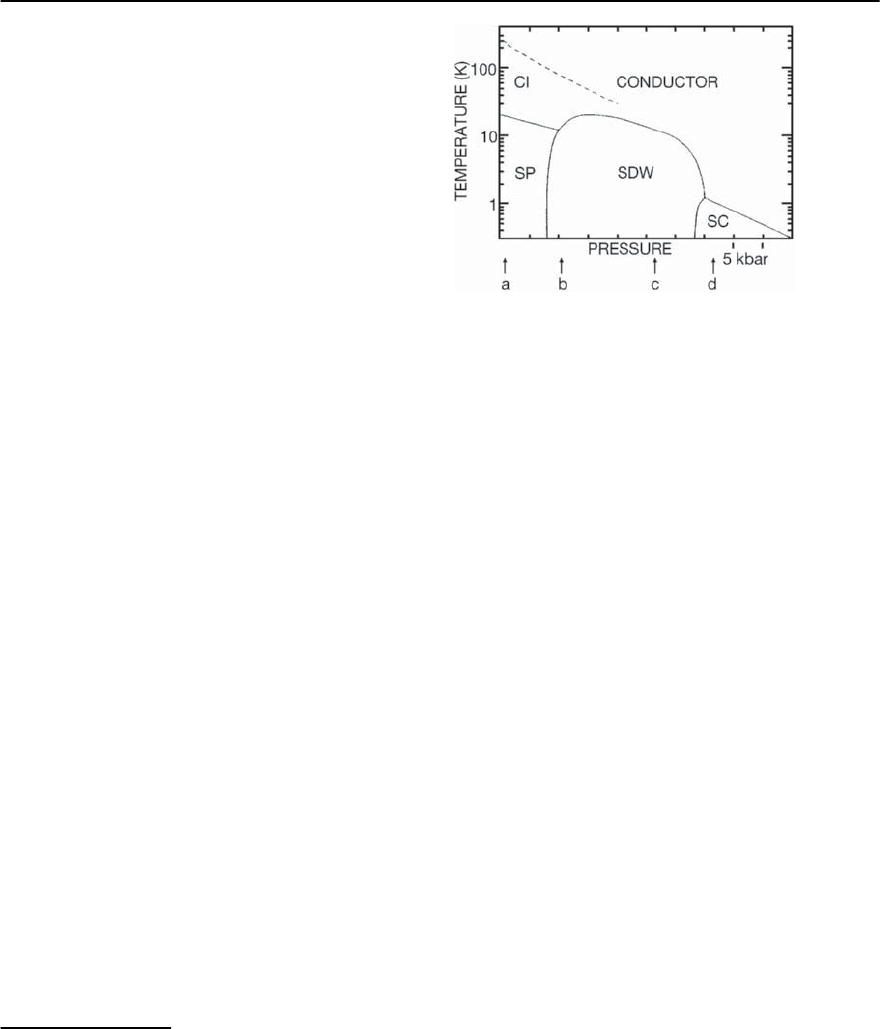
20 Organic Superconductors 1179
20.3.5 Phase Diagrams
(TM)
2
X Salts
Figure 20.22 comprises in a pressure-temperature
plane results of various experiments on the quasi-1D
charge-transfer salts (TMTTF)
2
X and their selenium
analogues (TMTSF)
2
X.Thearrowsindicatetheposi-
tion of the various salts at ambient pressure (cf. also
Fig. 20.10). The generic character of the phase dia-
gram, which was first proposed by J´eromeet al.[138],
has been demonstrated recently by pressure studies
on the (TMTTF)
2
PF
6
salt [66,67,179] for which the
ambient-pressure ground state is a dimerized spin-
Peierls state. With increasing pressure, the system
was found to pass through the whole sequence of
ground states as shown in Fig. 20.23 and eventually
becoming superconducting at high pressures above
43.5 kbar [67,179].On the low-pressure (left) side of
the phase diagram in Figs.20.22and 20.23 the molec-
ular stacks can be considered as only weakly-coupled
chains, i.e. the system is close to be truly 1D. In fact
upon cooling,the (TMTTF)
2
PF
6
compound behaves
very much like canonical 1D conductors where spin
and charge degrees of freedom are decoupled: below
T
= 250 K the resistivity increases by several or-
ders of magnitude due to charge localization while
the spin susceptibility remains unaffected [6,33,77].
The phase below T
has been interpreted as a Mott
insulating state. Upon further cooling to T
SP
=19K
a spin gap opens and the system enters a distorted
spin-Peierls ground state. In (TMTTF)
2
Br, position
(b)Figs.20.22and20.23,along-rangemagnetic order
is established below the spin-density-wave transition
at T
SDW
≈ 13 K. Toward the right side of the phase
diagram, which can be carried out either by varying
the anion or by the application of hydrostatic pres-
sure, inter-stack interactions become more impor-
tant.In this region of the phase diagram the electron–
phonon interaction is less dominant and electron–
electron interactions along with the good nesting
properties of the Fermi surface (cf. Fig. 20.7) lead to
Fig. 20.22. Generalized phase diagram for the quasi-1D
(TM)
2
X salts as proposed first by J´erome [138]. Arrows
indicate the positions of the salts with different anions X at
ambient pressure: (a) (TMTTF)
2
PF
6
,(b) (TMTTF)
2
Br, (c)
(TMTSF)
2
PF
6
,(d) (TMTSF)
2
ClO
4
.The following abbrevia-
tions are used: charge-localised insulator (CL), spin Peierls
(SP), incommensurate spin-density-wave (SDW) and su-
perconductivity (SC) (taken from [180])
a spin-density-wave ground state as observed, e.g. in
theBechgaard salt(TMTSF)
2
PF
6
atambient pressure.
After suppression of the SP phase in (TMTTF)
2
PF
6
with increasing pressure, a commensurate antiferro-
magnetic state is adopted beforean incommensurate
SDW phase is stabilized. With increasing pressure,
T
SDW
becomes progressively reduced until, above
some critical pressure, the systems remain metal-
lic and superconductivity replaces the SDW ground
state. The effect of pressure is to increase the -
orbital overlap also in the transverse direction, i.e.
perpendicular to the stacking axis. As a result the
almost perfect nesting properties are destroyed and
the systems become more 3D in character.
6
Accord-
ingto NMRexperiments[33,65]andrecent transport
measurements under hydrostatic pressure [67,179]
strong SDW correlations are still active in the metal-
lic state even when the SDW instabilityis replaced by
superconductivity in (TMTSF)
2
ClO
4
. The range of
strong SDW correlations for (TMTTF)
2
PF
6
derived
from these experiments is indicated in Fig. 20.23
6
Recent measurements under uniaxial strain revealed that the SDW transition is most strongly suppressed and su-
perconductivity can be induced by the strain along the stacking a-axis [181,182]. Considerably smaller effects were
observed for strain along the b
and c
-axes, although the former direction is directly associated with the denesting of
the quasi-1D Fermi surface [181]. This has been interpreted in terms of a pressure-induced decrease in the density of
states at the FS [183].
